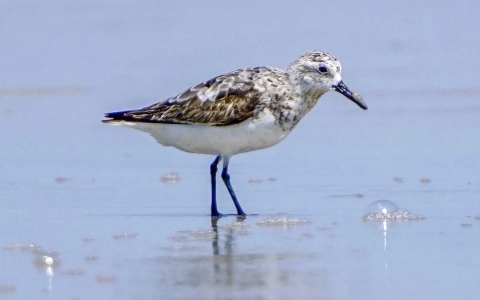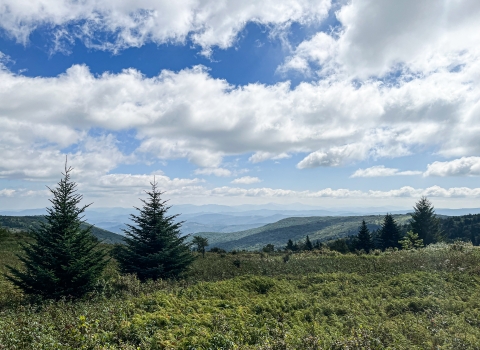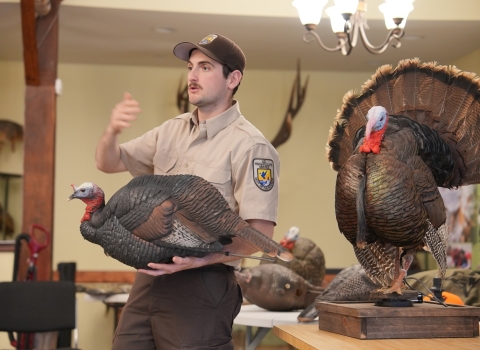Every year, an average of 250,000 visitors use Parker River NWR’s beaches, walking trails, and salt marshes for a variety of outdoor recreational activities, such as fishing, birding, and overall beach-going. Shorebirds, a group of birds that use habitat near water, are frequent visitors of the Refuge, particularly in the summer and fall. While people are enjoying the Refuge’s natural, pristine, and beautiful beaches, shorebirds are seeking a safe and sustainable place to breed, feed, and rest on the Refuge year-round. Shorebirds are easily disturbed by routine beach activities, which may impede on a successful migration. By using informational signs to educate visitors about shorebirds, the Refuge aims to provide the best experience for beachgoers and shorebirds alike.
For any questions please contact the refuge via email: heather_mcintosh@fws.gov
Sign Criteria
- Be an original piece of artwork. Creativity in artwork and messaging encouraged.
- Feature at least one of the seven shorebird species listed in the Shorebirds of Parker River NWR section.
- Incorporate text reinforcing a conservation message. See Conservation Message section for ideas. Text should be short, positive, legible, large, and easy to read.
- Communicate one of the themes below:
- Shorebird(s) actively using beach habitat (e.g. a plover on a nest or with chicks, a mixed group of shorebirds feeding on the beach).
- Actions beachgoers can take to help shorebirds (e.g. respecting closed areas and signs, walking around a flock of birds, picking up trash, not flying kites, not walking on dunes, etc.).
- Be accurate in regard to the species’ appearance and life history.
- Be designed with eye-catching elements (e.g. sharp and simple images, bold coloring, legible text, etc.) that can be easily interpreted by an audience, even at a distance.
- Be created on white paper or canvas, size 8.5” x 11”, with a ¾” border all around
Submission & Judging
Artwork must be submitted by April 30th, 2024. Only original pieces will be accepted. Label the back with student’s name, grade, school, and email contact. Students do not have to be enrolled in a school to participate. Please drop off submissions in person, or send by mail, to: Parker River NWR, 6 Plum Island Turnpike, Newburyport, MA 01950. Virtual submissions can also be submitted by emailing a scanned copy or photo of the artwork (please make sure the image resolution is at least 300 dpi, and keep a hard copy of the artwork on hand).
Each submission will be separated into one of the five groups listed below for judging. One winner from each group will be selected. Winners will be announced at Let's Go Outside on June 15, 2024. All participant art will also be displayed at Let's Go Outside in our Youth Showcase!
Group 1: Kindergarten
Group 2: 1st grade – 2nd grade
Group 3: 3rd grade – 5th grade
Group 4: 6th grade – 8th grade
Group 5: 9th grade – 12th grade
The winners from each group will receive the following prizes:
- Their artwork recreated into signs to be posted on the Refuge beach from April to October
- An annual pass to Parker River NWR - in the student’s name
- A customized water bottle featuring your artwork
A Grand Prize winner will also be selected. In addition to the above prizes, they and an accompanying guardian will get a chance to help a plover biologist conduct plover surveys and management on the closed Refuge beach.
All entries will be showcased at the Parker River Visitor Center during our annual Let's Go Outside event on June 15, 2024.
Conservation Message
The winning artwork signs will complement existing signs the Refuge uses and engage a larger community in this outreach campaign. Submissions should convey one of the following conservation messages:
- Respect closed areas and symbolic fencing
- Leave your kite in the car - birds see these as predators, like hawks and falcons
- Give feeding and resting shorebirds plenty of room -
- Pack out trash to avoid attracting predators
- Leave your pets at home
- A conservation message of your own creation (please write on back of art)!
Shorebirds of Parker River NWR
Here at Parker River NWR, many species of shorebird use the beach during spring, summer, and fall during their migration. Some species use the Refuge as a rest stop to feed while others come to nest and raise their chicks until they too are ready to migrate. We have highlighted seven species to provide background information for the contest: semipalmated sandpiper, red knot, sanderling, semipalmated plover, least tern, and black-bellied plover. Students may use the pictures and information on the following pages for reference and inspiration, but are encouraged to do their own research and create their own unique art. The Watch Out! Statements are provided to help students incorporate their conservation message. For more information check out the following websites:
Shorebird Resources – BirdsCaribbean
Semipalmated Sandpiper | Semipalmated sandpipers breed in Canada and winter in South America, and use the Refuge beach to fuel up for their long flight. They can fly thousands of miles, sometimes flying non-stop for four days. When they are at Parker River, they need to fuel up quickly, get plenty of rest and get on their way. Watch Out! Sandpipers feed in the wet sand at low tide, or rest in the upper beach, camouflaged in wrack (beach debris left over by the high tide). https://www.allaboutbirds.org/guide/Semipalmated_Sandpiper/lifehistory |
Called the Moon Bird, the red knot is the one of the longest migrators in the world. They nest in the Arctic and winter in Argentina, flying 20,000 miles in one year. One banded red knot (B95) is at least 22 years old, and has flown roughly 239,000 miles- equivalent to flying to the moon, back, and then some! Watch Out! This bird visits the Refuge from September into November. Because of their long flights and poor population numbers, give them plenty of room to feed or rest. | |
Sanderlings can often be seen scurrying in and out of the surf, picking up stranded insects or probing for clams and invertebrates after waves have receded. Small flocks will use the Refuge beach throughout the year. Watch Out! Flocks of sanderlings are constantly running in and out of the waves to forage as you play along the ocean’s edge. | |
Unlike the piping plover, semipalmated plovers are very common throughout their range. Even though they do not breed on the Refuge in the summer, our beaches provide important resources for them to feed and rest as they migrate. Watch Out! Semipalmated plovers hide amongst mixed flocks of other migrating shorebirds. Large groups of resting plovers blend into the debris washed up by the high tide. http://animaldiversity.org/accounts/Charadrius_semipalmatus/ | |
Black-bellied plovers are the largest plover in North America and are seen here at Parker River typically during migration. Aside from its striking appearance and size, this species is unique from other American plovers because it is the only one to have an inconspicuous hind toe. Watch Out! This shorebird is known for being especially cautious and quick to leave a feeding or resting area. Give them extra space to avoid disturbance. https://www.allaboutbirds.org/guide/Black-bellied_Plover/lifehistory | |
Piping plovers, known for their signature “peep” call and cotton ball looking chicks, are one of the most well-known shorebirds. Thanks to strong outreach and beach protection, the population has increased dramatically in Massachusetts, and is close to meeting its recovery goals. In order to do that, we need every beach goer’s help to make sure that every egg and chick has the best chance of becoming an adult. Watch Out! Signs are posted on beaches in the summer to indicate closed areas or nests nearby. Be aware of eggs and chicks that blend perfectly into the sand. | |
Least terns are colony nesters. The refuge hosts anywhere from 10 to 100 pairs every summer. Nests are just small, shallow scrapes in the sand with camouflaged eggs, making them difficult to see. Once chicks hatch, adults are often seen diving for and carrying small fish to feed their young. Watch Out! Least terns are very defensive during the nesting season. If you come too close to their nests or chicks, adults do not hesitate to dive bomb your head, rarely actually striking, but typically dropping feces. |











